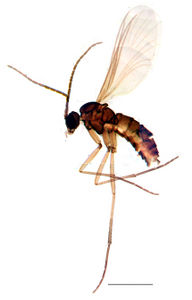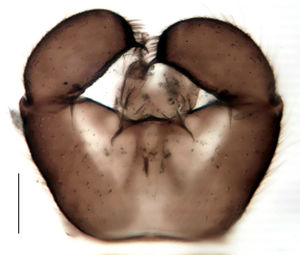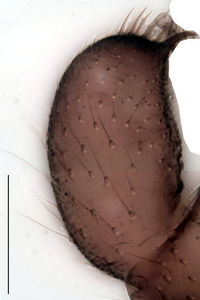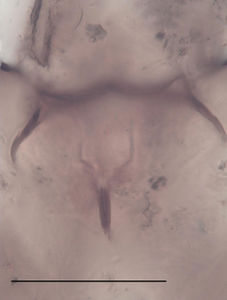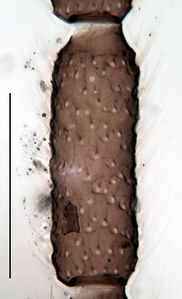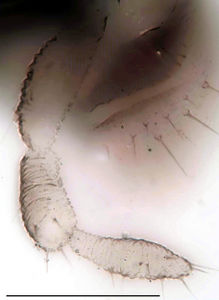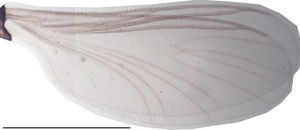Trichosiopsis rotunda
Ordo: Diptera
Familia: Sciaridae
Genus: Trichosiopsis
Name
Trichosiopsis rotunda (Mohrig & Mamaev, 1990) – Wikispecies link – ZooBank link
- Trichosia (Leptosciarella) rotunda Mohrig & Mamaev, 1990[1]: 223, fig. 3
- Leptosciarella (Leptosciarella) rotunda (Mohrig & Mamaev, 1990)[2]: 71, fig. 19
Type material
Holotype: ♂, 08.05.1963, leg. Mamaev, PWMP 4029
Type locality
Turkmenistan, Badkhys
Paratype
Turkmenistan: 1 ♂, same data as holotype, PWMP 4030.
Description (male)
Head. Eye bridge 3 rows of facets. LW-index of 4th antennal flagellar segment 1.55–1.8; neck 0.34–0.44 of segment width; Transition of basal part to neck pronounced. Colour of neck unicolour. Antennal hairs shorter than segment width; dense; salient. Palps darkened; normal; palpomeres 3. First palpomere of normal shape; with 3–5 bristles; with only some sparse sensillae. Second palpomere shortly oval. Third palpomere as long as first segment. Thorax. Colour bright brown. Notum unicolour. Thoracic setae normal; bright. Mesonotum with some weaker central bristles. Posterior pronotum setose. Postpronotal setae 1–2; fine. Mesothoracic sclerites bare. Legs. Colour yellow. Hind coxae of same colour as femora. Hairs on fore coxae bright. Front tibia apically with a patch of setae. Front tibial organ bright. Front tibial organ not bordered. Tibial setae on hind legs weak, inconspicuous, or normal, shorter than tibial width. Tibial spurs of equal length. Claws untoothed. Wings. Wings slightly darkened; of normal shape. Wing membrane without macrotrichia. Wing venation weak, with faint m-base. M-fork of normal shape. R1 inserting clearly before base of m-fork; posterior veins with macrotrichia; stM bare; cuA1 and cuA2 bare; bM bare; r-m bare, or with a few setae; r1:r 1–1.25; C:w 0.27–0.37. Halteres dark; of normal length. Abdomen. Abdominal setae weak; dorsally white; ventrally white. Hypopygium concolour with abdomen; 0.45–0.65 × longer than wide. Base of gonocoxites with normal, weak hairs; gonocoxites broadly separated; inner margin of gonocoxites broadly extended; inner membrane of hypopygium bare; elongated setae on valves of hypopygium absent. Gonostylus globular; 1.75–1.92 × longer than wide; Inner margin straight, or convex; apex equally rounded. Apical tooth present; 3.1–3.4 × longer than broad; strong. Awl-like setae long; on inner side of gonostyles absent. Megasetae on inner part of gonostylus absent. Whiplash-hair absent. Tegmen 0.4–0.7 × longer than broad; equally rounded; normal; Central process absent. Length of aedeagus/hypopygium 10–18 %; Aeadeagal apical structure absent. Measurements. Body size 2.5–3 mm. Hind tibia 1.06–1.22 mm. Wing length 2.1–2.5 mm.
Diagnosis
Trichosiopsis rotunda is well characterized by the nearly bare posterior wing veins and the very long awl-like setae at the gonostyli dorsally of the apical tooth. In general aspect it resembles Trichosiopsis claviforceps, which also has a bright tibial organ, but less rounded gonostyli with shorter awl-like setae.
Discussion
By the rounded gonostyles this species belongs to the viatica-complex of species and here to the subgroup of species with reduced macrotrichia on the wing veins. The species is currently only known by the two type specimens. The unusually long and curved apical tooth and the rounded gonostyles remind of species of Hirtipennia. Mohrig & Menzel (1997[2]: 71) discuss a possible relationship to Leptospina.
Etymology
lat. rotundus = round; making reference to the rounded gonostyles.
Distribution
Turkmenistan[1].
Images
|
References
- ↑ 1.0 1.1 Mohrig, W.; Krivosheina, N.; Mamaev, B. 1990: Beiträge zur Kenntnis der Trauermücken (Diptera, Sciaridae) der Sowjetunion. Teil XV. Gattungen (Sciara, Trichosia, Chaetosciara, Pharetratula, Parapnyxia, Epidapus und Caenosciara). Zoologische Jahrbücher, Abteilung für Systematik, Ökologie und Geographie der Tiere, 117(2), 219–236.
- ↑ 2.0 2.1 Mohrig, W.; Menzel, F. 1997: Revision der paläarktischen Arten von Trichosia Winnertz sensu Tuomikoski, 1960 (Diptera, Sciaridae). – Teil II. Gattungen Leptosciarella Tuomikoski, 1960 und Trichodapus gen. nov. Studia dipterologica, 4(1), 41–98.
